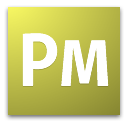 W
WAdobe PageMaker is a discontinued desktop publishing computer program introduced in 1985 by Aldus on the Apple Macintosh. The combination of the Macintosh's graphical user interface, PageMaker publishing software, and the Apple LaserWriter laser printer marked the beginning of the desktop publishing revolution. Ported to PCs running Windows 1.0 in 1987, PageMaker helped to popularize both the Macintosh platform and the Windows environment.
 W
WAmigaOS is a family of proprietary native operating systems of the Amiga and AmigaOne personal computers. It was developed first by Commodore International and introduced with the launch of the first Amiga, the Amiga 1000, in 1985. Early versions of AmigaOS required the Motorola 68000 series of 16-bit and 32-bit microprocessors. Later versions were developed by Haage & Partner and then Hyperion Entertainment. A PowerPC microprocessor is required for the most recent release, AmigaOS 4.
 W
WCornerstone is a relational database for MS-DOS by Infocom. It was widely hailed upon its release in 1985 for its ease of use, but is generally considered one of the leading factors in the demise of the company.
 W
WDeluxe Paint, often referred to as DPaint, is a bitmap graphics editor series created by Dan Silva for Electronic Arts. The original Deluxe Paint was written for the Commodore Amiga 1000 and released in November 1985. It was eventually ported to other platforms, including an MS-DOS version which became the standard for pixel graphics in video games in the 1990s, the only competitor being Autodesk Animator Pro.
 W
WThe DTJ-BBS was a program for the Commodore 64 written by Andrew Bernhardt. The first version was released in 1985, and sold for $35. There were forty DTJ systems before the software changed to freeware in 1989.
 W
WDOS Plus was the first operating system developed by Digital Research's OEM Support Group in Newbury, Berkshire, UK, first released in 1985. DOS Plus 1.0 was based on CP/M-86 Plus combined with the PCMODE emulator from Concurrent PC DOS 4.11. While CP/M-86 Plus and Concurrent DOS 4.1 still had been developed in the United States, Concurrent PC DOS 4.11 was an internationalized and bug-fixed version brought forward by Digital Research UK. Later DOS Plus 2.x issues were based on Concurrent PC DOS 5.0 instead. In the broader picture, DOS Plus can be seen as an intermediate step between Concurrent CP/M-86 and DR DOS.
 W
WFast Hack'em is a Commodore 64 fast disk/file copier, nibbler and disk editor written by Mike J. Henry and released in 1985. It was distributed in the U.S. and Canada via Henry's "Basement Boys Software", and in the U.K. via Datel Electronics. In the U.S., it retailed for $29.95.
 W
WFreeGEM released in 1999 is a windowing system based on Digital Research's GEM which was first released in 1985. GEM stands for "Graphics Environment Manager".
 W
WGarry Kitchen's GameMaker is an integrated development environment for the Commodore 64, Apple II, and IBM PCs, created by Garry Kitchen and released by Activision in 1985. It is one of the earliest all-in-one game design products aimed at the general consumer, preceded by Broderbund’s The Arcade Machine in 1982. Several sample files are included: a demo sequence featuring animated sprites and music, a recreation of Pitfall!, and a birthday greeting.
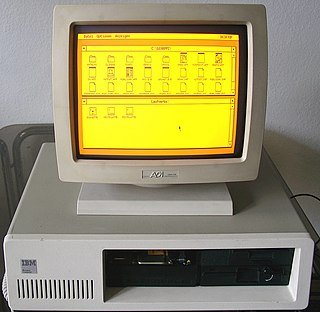 W
WGEM is an operating environment which was created by Digital Research (DRI) since 1984 for use with the DOS operating system on Intel 8088 and Motorola 68000 microprocessors.
 W
WGraphic Adventure Creator is a game creation system/programming language for adventure games published by Incentive Software, originally written on the Amstrad CPC by Sean Ellis, and then ported to other platforms by, amongst others, Brendan Kelly (Spectrum), Dave Kirby and "The Kid" (C64). The pictures in the demo adventure, Ransom, were made by Pete James and the box cover art by Pete Carter.
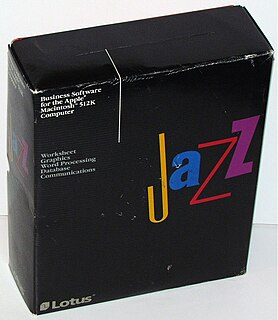 W
WLotus Jazz is an integrated suite of word processor, spreadsheet, database, graphics, and communication software designed for the Macintosh 512K. It was released in 1985 and retailed for US$595. The Lotus 1-2-3 spreadsheet was the killer application for the business-oriented IBM PC, and Jazz was an attempt to recreate that success for Macintosh. With the tagline "The software Macintosh was invented for," and promoted on TV at great expense, it was poorly received by reviewers and consumers and became a high-profile flop. In 1988, Lotus was on the verge of releasing an improved version as Modern Jazz, but the project was cancelled.
 W
WMicroEMACS is a small, portable Emacs-like text editor originally written by Dave Conroy in 1985, and further developed by Daniel M. Lawrence (1958–2010) and was maintained by him. MicroEMACS has been ported to many operating systems, including CP/M, MS-DOS, Microsoft Windows, VAX/VMS, Atari ST, AmigaOS, OS-9, and various Unix-like operating systems.
 W
WMicrosoft Excel is a spreadsheet developed by Microsoft for Windows, macOS, Android and iOS. It features calculation, graphing tools, pivot tables, and a macro programming language called Visual Basic for Applications (VBA). It has been a very widely applied spreadsheet for these platforms, especially since version 5 in 1993, and it has replaced Lotus 1-2-3 as the industry standard for spreadsheets. Excel forms part of the Microsoft Office suite of software.
 W
WMicrosoft Paint is a simple raster graphics editor that has been included with all versions of Microsoft Windows. The program opens and saves files in Windows bitmap (BMP), JPEG, GIF, PNG, and single-page TIFF formats. The program can be in color mode or two-color black-and-white, but there is no grayscale mode. For its simplicity and that it is included with Windows, it rapidly became one of the most used applications in the early versions of Windows, introducing many to painting on a computer for the first time. It is still widely used for simple image manipulation tasks.
 W
WMicrosoft Write was a basic word processor included with Windows 1.0 and later, until Windows NT 3.51. Throughout its lifespan it was minimally updated, and is comparable to early versions of MacWrite. Early versions of Write only work with Write (.wri) files, but after Windows 3.0, Write became capable of reading and composing early Word (.doc) documents. With Windows 3.1, Write became OLE capable. In Windows 95, Write was replaced with WordPad. If you try to open Write from the Windows folder, it will open WordPad instead.
 W
WNEOchrome is an early color bitmap graphics editor for the Atari ST. It was written by Dave Staugas, a programmer at Atari Corporation and co-author of the ST's operating system. NEOchrome supports hardware-supported color cycling to give the impression of animation. A color cycling waterfall, created with NEOchrome, was one of the iconic images of the early Atari ST.
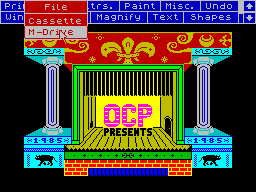 W
WOCP Art Studio or Art Studio was a popular bitmap graphics editor released in 1985, created by Oxford Computer Publishing and written by James Hutchby.
 W
WMicrosoft QuickBASIC is an Integrated Development Environment and compiler for the BASIC programming language that was developed by Microsoft. QuickBASIC runs mainly on DOS, though there was also a short-lived version for the classic Mac OS. It is loosely based on GW-BASIC but adds user-defined types, improved programming structures, better graphics and disk support and a compiler in addition to the interpreter. Microsoft marketed QuickBASIC as the introductory level for their BASIC Professional Development System. Microsoft marketed two other similar IDEs for C and Pascal, viz QuickC and QuickPascal.
 W
WStarOffice, known briefly as Oracle Open Office before being discontinued in 2011, is a proprietary office suite. It originated in 1985 as StarWriter by Star Division, which was acquired by Sun Microsystems in 1999. Sun Microsystems, in turn, was acquired by Oracle Corporation in 2010.
 W
WTurbo-BASIC XL is an advanced version of the BASIC programming language for the Atari 8-bit family of home computers. It is a compatible superset of the Atari BASIC that was built-in to most Atari machines of the era.
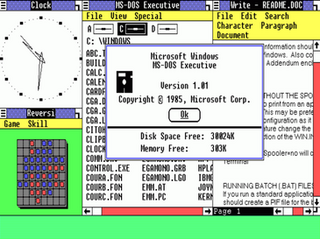 W
WWindows 1.0 is a graphical personal computer operating environment developed by Microsoft. Microsoft had worked with Apple Computer to develop applications for Apple's January 1984 original Macintosh, the first mass-produced personal computer with a graphical user interface (GUI) that enabled users to see user friendly icons on screen. Windows 1.0 was released on November 20, 1985, as the first version of the Microsoft Windows line. It runs as a graphical, 16-bit multi-tasking shell on top of an existing MS-DOS installation. It provides an environment which can run graphical programs designed for Windows, as well as existing MS-DOS software. Its development was spearheaded by the company founder Bill Gates after he saw a demonstration of a similar software suite known as Visi On at COMDEX.
 W
WWindows Calculator is a software calculator developed by Microsoft and included in Windows. It has four modes: standard, scientific, programmer, and a graphing mode. The standard mode includes a number pad and buttons for performing arithmetic operations. The scientific mode takes this a step further and adds exponents and trigonometric function, and programmer mode allows the user to perform operations related to computer programming. Recently, a graphing mode was added to the Calculator, allowing users to graph equations on a coordinate plane.
 W
WXfig is a free and open-source vector graphics editor which runs under the X Window System on most UNIX-compatible platforms.